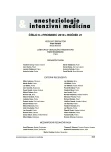-
Medical journals
- Career
High frequency jet ventilation applied via a catheter for Fantoni’s tracheostomy
Authors: Čandík Peter; Hermely Albert; Török Pavol; Sopko Imrich; Sýkora René
Authors‘ workplace: KAIM VÚSCH, a. s., LF UPJŠ Košice, Slovenská republika
Published in: Anest. intenziv. Med., 21, 2010, č. 6, s. 324-330
Category: Intensive Care Medicine - Original Paper
Overview
Objective:
The main goal of this work was trying to replace conventional ventilation using an original, small internal diameter, long-cuffed endotracheal (ET) tube with a high flow resistance, by high-frequency jet ventilation applied via a special catheter (C-HFJV).
The authors describe the use of high-frequency jet ventilation applied via a catheter for a translaryngeal (retrograde) tracheostomy by Fantoni (TLT).Type of study:
Prospective observational study.Setting:
Department of Anaesthesia and Intensive Medicine.Materials and methods:
The authors were using the following equipment for TLT: a flexible bronchoscope, a HFJV ventilator witch a catheter and the Translaryngeal Tracheostomy Kit (Malincrodt Medical GmbH, Hennef, Germany). Sufficient ventilation for performing the TLT was achieved by high-frequency jet ventilation delivered through a 2-way prototype ventilation-catheter (C-HFJV) in a group of 10 patients.Results:
There was no significant negative impact on the basic vital signs in any of the cases. A comparison of pH, SpO2, PaO2 and PaCO2 changes before and after the application of C-HFJV did not show a statistically significant difference. PEEPi generated during C-HFJV did not exceed 4–5 cm H2O, whereas during conventional ventilation via the original ET tube it was fluctuating between 15–17 cm H2O.Conclusion:
The authors conclude that this modification of the Fantoni tracheostomy method improves the ventilation parameters and shortens the procedure.Keywords:
translaryngeal tracheostomy – HFJV via a catheter
Sources
1. Fantoni, A. Translaryngeal tracheostomy. In Gullo, A. (ed) APICE: Trieste, 1993, p. 459–465.
2. Fantoni, A., Ripamonti, D. A breakthrough in tracheostomy techniques: translaryngeal tracheostomy. In Roussos, C. (ed) Proceedings of 8th European congress of intensive care medicine. Athens, 1995, p. 1031–1034.
3. Platz, A., Kleinstück, F., Kohler, A., Stocker, R., Trentz, O. Percutaneos tracheostomy: a minimally invasive procedur on the intensive care unit. Swiss Surg., 1996, 2, p. 42–45.
4. Byhahn, C., Wilke, H., Lischke, V., Rinne, T., Westphal, K. Bedside percutaneous tracheostomy: clinical comparison of Griggs and Fantoni techniques. World J. Surg., 2001, 1, p. 296–301.
5. Konopke, R, Zimmermann, T. et al. Prospective evaluation of the retrograde percutaneous translaryngeal tracheostomy (Fantoni procedure) in a surgical intensive care unit: Technique and results of the Fantoni tracheostomy. Head and Neck, 2006, 2, p. 355–359.
6. Török, P., Káli, K. Teoretičeskoe i kliničeskoe osnvy vysokočastotnoj ventilacii. ABM: Ekaterinburg, 2005, p. 190.
7. Kálig, K., Haruštiak, S., Brychta, O., Yaghi, A., Vlček, Z., Ondrejovič, S. HFJV in recinstructive surgery od trachea. In Mutz, N. J., Koller, W., Benzer, H. Abstracts of 7th European Congress on intensive care. Insbruck, 1994, p. 809–814.
8. Kálig, K. Katétrová VFDV v rekoštrukčnej chirurgii trachey. Kandidátska dizertačná práca, LF Univerzity Komenského v Bratislave, 1999.
9. Horst, A., Hemprich, A., Koch, C., Oeken, A., Schmidt, J. H., Schramek, J., Frerich, J. Safety and practicability of percutaneous translaryngeal tracheotomy (Fantoni technique) in surgery of maxillofacial and oropharyngeal tumours – Own results and review of the literature. Journal of Cranio-Maxillofacial Surgery, 2008, 1, p. 38–46.
Labels
Anaesthesiology, Resuscitation and Inten Intensive Care Medicine
Article was published inAnaesthesiology and Intensive Care Medicine

2010 Issue 6-
All articles in this issue
- Comparison of patient satisfaction after general and regional anaesthesia in total hip and knee replacement surgery
- High frequency jet ventilation applied via a catheter for Fantoni’s tracheostomy
- Dynamics of the neurofilament pNF-H as a predictor of mortality in children with brain injury
- Septic shock in fatal pneumonia caused by Staphylococcus aureus: The significance of producing Pantone-Valentine leukocidine – case report
- Thrombocytes in sepsis
- In-hospital therapeutic hypothermia in cardiac arrest survivors: Growing implementation in the Czech Republic (PRE-COOL 2: Hospital Survey 2008)
- Anaesthesiology and Intensive Care Medicine
- Journal archive
- Current issue
- Online only
- About the journal
Most read in this issue- Septic shock in fatal pneumonia caused by Staphylococcus aureus: The significance of producing Pantone-Valentine leukocidine – case report
- Comparison of patient satisfaction after general and regional anaesthesia in total hip and knee replacement surgery
- Thrombocytes in sepsis
- High frequency jet ventilation applied via a catheter for Fantoni’s tracheostomy
Login#ADS_BOTTOM_SCRIPTS#Forgotten passwordEnter the email address that you registered with. We will send you instructions on how to set a new password.
- Career

